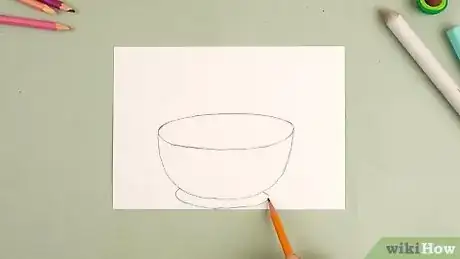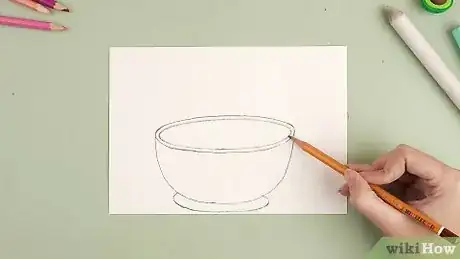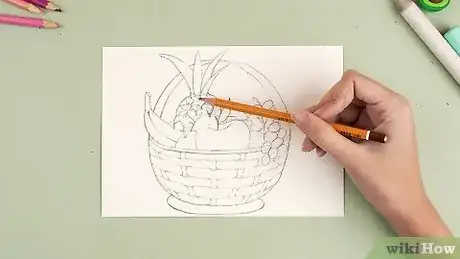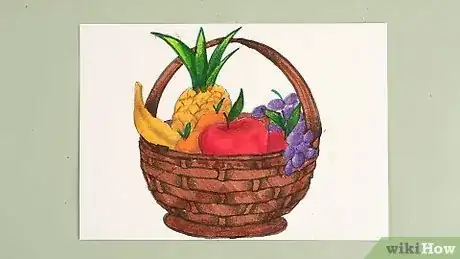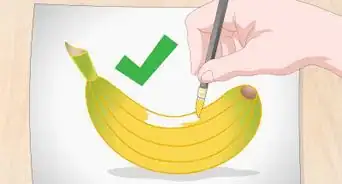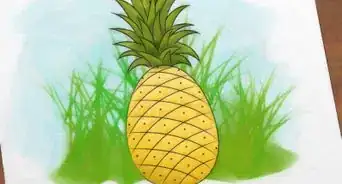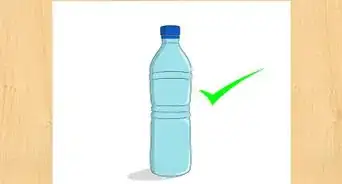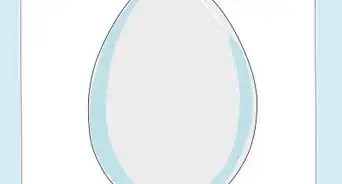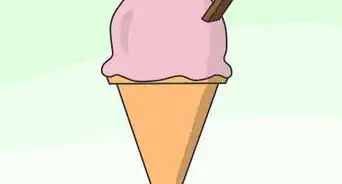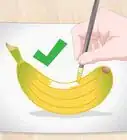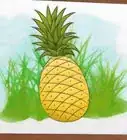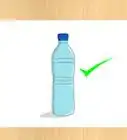This article was co-authored by Rebecca Schweiger and by wikiHow staff writer, Jessica Gibson. Rebecca Schweiger is a Professional Artist, Published Author, and the Founder of The Art Studio NY, New York City's #1-rated art school and global online art studio. Celebrated by TV networks, press, and celebrities including NBC, ABC, E!, Time Out New York, The Kardashians, and Big Bang Theory's Jim Parsons, Rebecca specializes in creating abstract artwork and teaching studio art classes. Her art studios provide 100+ weekly, beginner-friendly drawing and painting art classes to people around the globe. With more than 22 years of art experience, she is the author of Release Your Creativity: Discover Your Inner Artist with 15 Simple Painting Projects, and her artwork has been exhibited in more than 50 museums and galleries around the world. Rebecca holds a BFA in Painting from Boston University's School for the Arts and has participated in acclaimed artist residencies worldwide.
There are 10 references cited in this article, which can be found at the bottom of the page.
wikiHow marks an article as reader-approved once it receives enough positive feedback. In this case, 80% of readers who voted found the article helpful, earning it our reader-approved status.
This article has been viewed 500,929 times.
A basket of fruit might seem like a simple thing to sketch, but it teaches you a variety of useful drawing skills. You'll work on perspective and depth when you sketch the basket. If you draw real fruit, you'll also get practice with creating a still life. To make your basket of fruit more realistic, work on shading and hatching so your fruit appears 3-dimensional. Play around with the composition until you're happy with the results.
Steps
Sketching the Basket
-
1Draw a horizontal oval that's as long as you want the basket to be. Use a pencil and lightly sketch the oval so you can go back and erase lines as needed. This oval will be the top rim of the basket so make it wide enough for the fruit to fit inside.[1]
- Keep in mind that you won't see all of the oval once you fill your basket with fruit.
-
2Make a thick crescent shape extending from the bottom of the oval. To sketch the basket, draw a large curve from 1 end of the oval down and back up to the other end. The bottom line of the oval will make your basket shape look like a thick crescent.[2]
- To make a shallow bowl instead of a deep basket, draw a narrow crescent below the oval.
Advertisement -
3Create a small ring at the bottom of the basket to make a base. Although most baskets don't have bases, you can draw a narrow ring at the bottom to give your basket something to balance on.[3]
- To give your basket edge a woven look, make the ring for the base extend along the length of the basket.
-
4Draw a parallel oval around the rim to give the basket dimension. Sketch your surrounding oval so it's slightly larger than the first oval you drew. Make the larger oval slightly narrower on the side of the basket that will be farther away from you. [4]
- The distance between the 2 ovals will depend on the size of your drawing. For example, your ovals might only be about 1⁄4 inch (0.64 cm) apart.
-
5Sketch 2 arcs that stretch across the basket to make a handle. Draw 1 curved line from the middle of the oval up and down to the opposite side of the oval. Then, make another curve that's parallel. Make the distance between them as wide as you'd like the handle to be.[5]
- If you don't want your basket to have a handle, you can skip this step.
Tip: To connect the arcs for the handle, draw a small line across the top of the 2 arcs at the very top.
-
6Add hashed lines to give your basket a woven appearance. You can make your basket weaving as simple or complex as you like. Start by drawing lines that curve from the top left down to the bottom right of the basket. Keep making the lines about 1⁄2 inch (1.3 cm) apart, for instance. Then, repeat this but make the curves go from the top right down to the bottom left.[6]
- If you don't want to make the basket look woven, use a pencil and blending stump to shade the bottom and 1 side of the basket.
- A blending stump is very helpful when you draw with pencil or colored pencil.
- Instead of blending the colors with your fingers, you can blend them with a blending stump.[7]
- You can use a gentle circular motion, or apply gentle pressure and move it left and right or up and down to blend.[8]
- Refer to a real basket or photograph of a fruit basket in order to get ideas for the basket weave or style.
Drawing the Fruit
-
1Draw half-circles inside the middle of the basket to make apples. Decide how many apples you'd like to place in your basket and sketch a half-circle for each apple near 1 end of the basket. Give each half-circle a slight dip near the stem so your apple isn't perfectly round. Go back and draw a small stem poking out of the top of each apple.[9]
- Draw the apples so they overlap a little and keep in mind that apples near the front of your basket will appear larger than ones that are tucked in the back.
- Practice drawing apples that are pointed in different directions so you see the stem on some or the bottom end on others.
-
2Make circular oranges with small flower stalks next to the apples. Sketch at least 1 or 2 circles or half-circles for the oranges. If you like, draw a very small circle on each orange and shade it in darker so it looks like the orange's flower stalk.[10]
- If your oranges are tucked into the basket, make the upper half that are closer to larger than the ones near the back of the basket. If your oranges are placed on top of other fruits, make them completely round.
-
3Sketch at least 1 to 2 bananas off to the side of the basket. Draw a long curve that looks like a smile and make a parallel curved line about 1 inch (2.5 cm) above it. Connect the ends of the curves to make the stem and tip of the banana. To create a cluster of bananas, draw another curved line so it's parallel to the top line. Then, draw a small square at 1 end in order to make the stems.[11]
- If you'd rather put the bananas in the middle of the basket, draw a cluster of them in the center. Remember that a cluster of 4 or 5 bananas are attached by the stem.
-
4Draw small circles that are clustered together to form a bunch of grapes. Give your basket of fruit an interesting dimension by draping the grapes from inside the basket over the side. Draw the grapes so they're small and coin-sized compared to the larger oranges and apples in your basket. If it helps, lightly draw the outline of the cluster so you know the overall shape of the grapes. Then, fill in the outline with lots of small circles.[12]
- To make the cluster look more realistic, draw a thin line between some of the grapes, which will look like a stem that's connecting them.
-
5Sketch a whole pineapple for an exotic fruit basket. To fill a large space in the basket, draw a large oval for the main part of the pineapple. Then, draw spiked leaves that are pointing up and away from the center of the basket.[13]
- To add detail to the pineapple, make cross hatches with a small dot in the center of each space.
-
6Use a blending stump to shade the fruit and give it dimension. If you'd like the fruit to look realistic, take a blending stump and gently rub it over the fruit to blur your pencil marks. Think about how a light source hits your fruit basket so you know where to place shadows and highlights. To create shadows, sketch over the fruit again to add extra graphite. Then, smudge the graphite with the blending stump to make a shadow effect.[14]
- For example, if the light is coming from the left of the basket, draw the shadows on the right.
- You can lift graphite from the paper by rubbing a clean blending stump over the graphite. This is useful if you'd like to highlight a spot on a piece of fruit.
Tip: To keep your basket of fruit simple or cartoon-like, avoid shading the drawing. Instead, go over your lines with a fine pen and erase the pencil.
-
7Erase unnecessary lines and color the drawing if you like. Go back over your drawing and look for lines that overlap onto pieces of fruit or the basket. Use a small eraser to remove these and then decide if you'd like your drawing to be colorful. Try using colored pencils, markers, or pastels to make your basket of fruit vibrant.[15]
Tip: If you added a lot of shading with your pencil, applying color might hide some of that detail.
-
8Finished.
Community Q&A
-
QuestionWhy do I need to sketch first?
 Community AnswerIt is necessary to sketch the design first because if you were to make a mistake, it'll be easy to fix it and work on improving it until it's right again.
Community AnswerIt is necessary to sketch the design first because if you were to make a mistake, it'll be easy to fix it and work on improving it until it's right again. -
QuestionDo I have to draw an outline to draw a basket of fruit?
 Community AnswerNo, this isn't essential but it does make the drawing easier because you have an outline to follow and infill. The alternative is drawing it without guidance.
Community AnswerNo, this isn't essential but it does make the drawing easier because you have an outline to follow and infill. The alternative is drawing it without guidance. -
QuestionWhy should I sketch and then rub the lines?
 Community AnswerIt is necessary to sketch and rub because you need a contour first. A contour gives shape to your drawing and when you make mistakes, you have to rub.
Community AnswerIt is necessary to sketch and rub because you need a contour first. A contour gives shape to your drawing and when you make mistakes, you have to rub.
Things You'll Need
- Paper
- Pencil
- Eraser
- Pen, optional
References
- ↑ http://www.supercoloring.com/drawing-tutorials/how-to-draw-a-basket-with-apples
- ↑ http://www.supercoloring.com/drawing-tutorials/how-to-draw-a-basket-with-apples
- ↑ https://youtu.be/G88gut9j8EE?t=30
- ↑ http://www.supercoloring.com/drawing-tutorials/how-to-draw-a-basket-with-apples
- ↑ http://www.supercoloring.com/drawing-tutorials/how-to-draw-a-basket-with-apples
- ↑ https://youtu.be/Vf5QJ1XWiwU
- ↑ https://rapidfireart.com/2015/05/08/detailed-guide-how-to-use-a-blending-stump/
- ↑ https://rapidfireart.com/2015/05/08/detailed-guide-how-to-use-a-blending-stump/
- ↑ http://www.supercoloring.com/drawing-tutorials/how-to-draw-a-bowl-of-fruits
- ↑ https://www.drawingnow.com/tutorials/119392/how-to-draw-an-orange/
- ↑ https://youtu.be/G88gut9j8EE
- ↑ http://www.supercoloring.com/drawing-tutorials/how-to-draw-grapes
- ↑ https://ourpastimes.com/how-to-draw-a-pineapple-12498835.html
- ↑ http://rapidfireart.com/2015/05/08/detailed-guide-how-to-use-a-blending-stump/
- ↑ http://www.supercoloring.com/drawing-tutorials/how-to-draw-a-bowl-of-fruits
About This Article
To draw a basket of fruit, start by sketching in the shape of the basket. Draw a wide, horizontal oval to represent the opening at the top of the basket, then a half-circle shape underneath for the body of the basket. Add a ring at the bottom of the basket for the base, and draw a smaller oval inside the top oval to give the basket a rim and make it look more three-dimensional. Draw two parallel curved lines going over the top of the basket to represent the handle, then add crisscrossing bands around the body of the basket to make it look woven. Sketch in the basic shapes of the fruit inside the basket, such as half-circles for apples and oranges, curved shapes for bananas, and smaller ovals for grapes, then fill in details such as stems and leaves. Erase any overlapping lines and add shading or color to the fruit to make it look more realistic.

